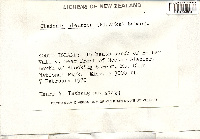
Consortium of Lichen Herbaria
- building a Global Consortium of Bryophytes and Lichens as keystones of cryptobiotic communities -
- Home
- Search
- Images
- Species Checklists
- US States: O-Z >
- US National Parks
- Central America
- South America
- US National Parks
- Southern Subpolar Region
|
|
|
|
Family: Cladoniaceae
Red-fruited Pixie-cup
[Capitularia pleurota Flörke, moreCladonia coccifera subsp. pleurota (Flörke) M. Hauck, Cladonia coccifera var. pleurota (Flörke) Schaer., Cladonia cornucopioides var. grandis Kremp., Cladonia cornucopioides var. pleurota (Flörke) F. Wilson] |
Nash, T.H., Ryan, B.D., Gries, C., Bungartz, F., (eds.) 2002. Lichen Flora of the Greater Sonoran Desert Region. Vol 1. Primary thallus: squamulose, evanescent or rarely persistent; squamules: 1-5 mm long, 0.5-4 mm wide, on lower side ochraceous toward bases podetia: greenish to whitish yellow, sometimes with bluish tint, up to 2.5 cm tall, cup-bearing; cups: up to 10 mm wide; margins: usually subentire, more rarely with teeth or proliferations surface: with a thick cortex, sometimes rugose (especially toward base), variably sorediate; soredia: usually in upper portions of podetia including cup interiors, granular or in part farinose Apothecia: infrequent, red, borne on cup margins ascospores: oblong, 8-12 x 2.5-3 micro meter Pycnidia: common, on cup margins (rarely on primary squamules), ovoid, with red gelatin conidia: 6-8 x 1 micro meter Spot tests: K-, C-, KC+ faintly yellow, P-, UV- or faintly whitish Secondary metabolites: thallus with usnic and isousnic acids, zeorin (present as abundant, very tiny needle crystals over surface in older herbarium specimens), occasionally porphyrilic acid (UV+); apothecial discs with rhodocladonic acid as a red pigment. Habitat and ecology: on rotting wood, soil or duff, largely temperate-boreal World distribution: all continents Sonoran distribution: Arizona. Notes: Cladonia pleurota is mostly restricted to inland localities at intermediate to high elevations. It is sometimes confused with C. carneola, which is brighter yellow and has abundant, very fine soredia down to the base of podetium, denticulate cup margins, and ochraceous apothecia. This species should be compared with C. coccifera, which has the same chemistry but is not sorediate (Stenroos 1989a & 1989b). See also the discussion under C. borealis. |
|
|
|
Powered by Symbiota






















































































